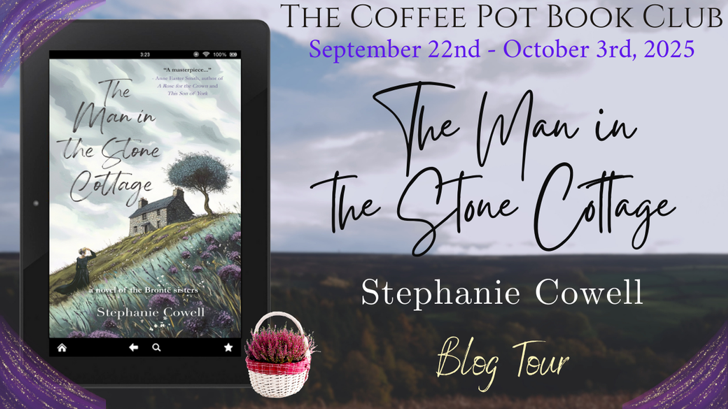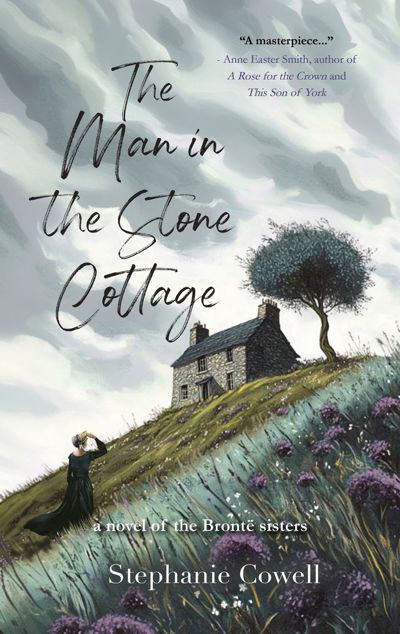
“A haunting and atmospheric historical novel.” – Library Journal
In 1846 Yorkshire, the Brontë sisters— Charlotte, Anne, and Emily— navigate precarious lives marked by heartbreak and struggle.
Charlotte faces rejection from the man she loves, while their blind father and troubled brother add to their burdens. Despite their immense talent, no one will publish their poetry or novels.
Amidst this turmoil, Emily encounters a charming shepherd during her solitary walks on the moors, yet he remains unseen by anyone else.
After Emily’ s untimely death, Charlotte— now a successful author with Jane Eyre— stumbles upon hidden letters and a mysterious map. As she stands on the brink of her own marriage, Charlotte is determined to uncover the truth about her sister’ s secret relationship.
The Man in the Stone Cottage is a poignant exploration of sisterly bonds and the complexities of perception, asking whether what feels real to one person can truly be real to another.

My Review
Like most English majors, I devoured the Bronte books many years ago, and they stayed with me all these years. So it was a real surprise to learn just how isolated these authors lived—more than isolated really. I would almost say sequestered. Especially Emily, the eventual author of Wuthering Heights who was reluctant to leave the house. How could these reclusive gals write such insightful novels? I was even more surprised to learn that Wuthering Heights didn’t make much of a splash in its day. Jane Eyre, on the other hand, was apparently an immediate success, pulling the struggling family out of poverty. This novel was the inspiration of Emily’s sister Charlotte, who also led a frustrated life, facing potential spinsterhood.
In many ways, the book reads like a dream. Emily’s experience with the mysterious stranger in the stone cottage takes up most of the story, and at times I wondered if she was imagining the whole thing. Her conflicting emotions must have driven her a bit crazy—not to mention the incredibly patient stranger:
“I was ill on and off then, so couldn’t return but I decided not to go away. I couldn’t go without seeing you again.”
She said uncomfortably, “I wish you had spoken to me when you came to the village.”
“I know you a little and you didn’t want it. I’m your secret. I sensed it. It gets lonely being a secret, lass.”
“I think of us as friends.”
“Strange friends indeed. ‘I won’t come to you, and you may not come to me.’ ‘I’ll see you in a year, maybe not.’” He smiled, teasing.
Of course, we do learn that he is a real person and she has been leading a double life. Her sisters were most surprised, needless to say. But they were also terribly distracted by the behaviour of their alcohol-sodden brother and their parson father who was going blind. Not a happy family, though they clung together. I wonder if getting published was easier in those days? Did the girls send off their first drafts? Their writing wasn’t the main focus of the book; their sad lives took precedence. I think we tend to forget that composing a novel might not even be the main purpose of a person’s life. With Emily, it seems, Wuthering Heights was more of an embarrassment rather than a triumph. Very interesting, indeed.
Universal Buy Link: https://books2read.com/u/mqLV2d
Meet Stephanie Cowell

Stephanie Cowell has been an opera singer, balladeer, founder of Strawberry Opera and other arts venues including a Renaissance festival in NYC.
She is the author of seven novels including Marrying Mozart, Claude & Camille: a novel of Monet, The Boy in the Rain and The Man in the Stone Cottage. Her work has been translated into several languages and adapted into an opera. Stephanie is the recipient of an American Book Award.
Connect with Stephanie
Website: https://stephaniecowell.com
Facebook: https://www.facebook.com/stephanie.cowell.14
Instagram: https://www.instagram.com/cowell.stephanie/
Amazon Author Page: https://www.amazon.com/author/stephaniecowell
Goodreads: https://www.goodreads.com/author/show/197596.Stephanie_Cowell